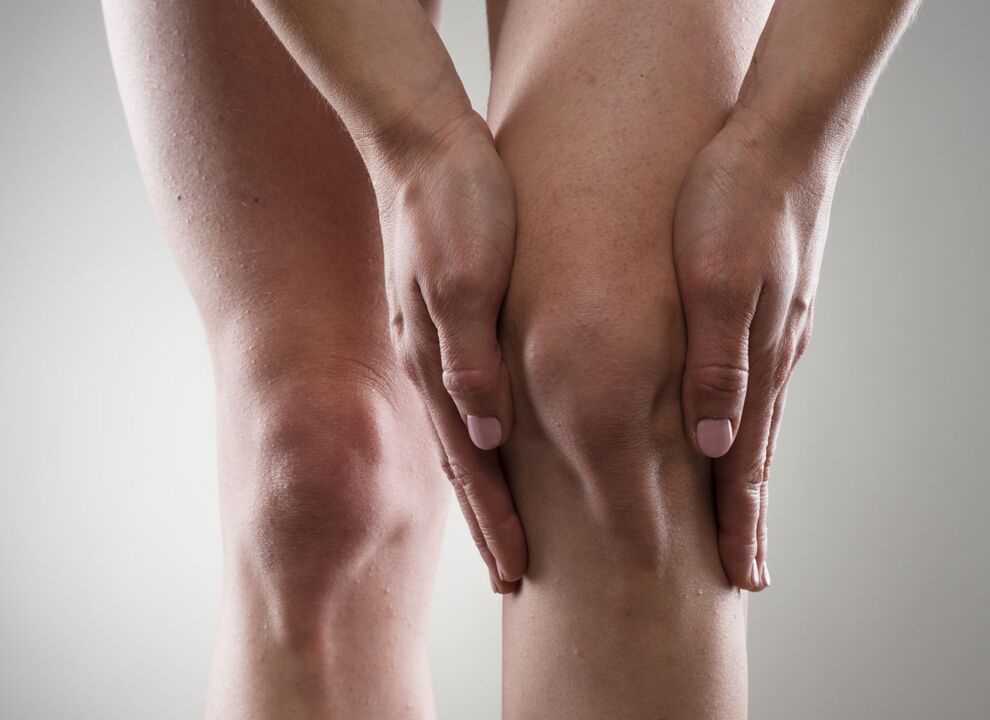
Knee osteoarthritis (knee osteoarthritis deformity, DOA, gonorrhea) is called a degenerative-dystrophic change in the structure of the joint, in which the layer of cartilage between the original bone elements becomes thinner andthen deflates. In the early stages, the patient feels uncomfortable and has limited movement, then the joints become deformed and the cartilage is destroyed, causing complete loss of function. Acute arthritis is very painful and is accompanied by a significant decrease in the patient's physical activity. If treatment for knee gonorrhea is not started promptly, the patient may become disabled.
For reference:According to statistics, 1 in 5 adults in the world has knee osteoarthritis. Knee osteoarthritis can be unilateral or bilateral; in women, the pathology is diagnosed twice as often as in men. People over 45 years old often face the problem of joint deformities due to age-related changes in the body. If this diagnosis is made in young people, the cause is usually trauma.
Why does pathology develop?
The knee joint is one of the most complex joints in the human body. It bears most of the load during walking and other movements. It is not surprising that with age, its elements begin to wear out and lose functionality. First, the cartilage in the joints loses its elasticity and elasticity, then dries out and cracks. The shock-absorbing properties of cartilage are reduced and this is the cause of discomfort and pain when moving: the shocks and impacts of joint structures on each other are no longer softened by anything. Anyway, the bones gradually exposed and rubbed against each other. .
Knee joint deformity in old age is an optional phenomenon, not everyone can diagnose it. There are a number of provoking factors, the combination of which causes pathological changes in the joints.
The most common causes of pathology are as follows:
- excess weight - the joint must withstand additional loads;
- Osteoporosis is a disease in which demineralization of bone tissue occurs;
- chronic diseases related to metabolic disorders in the body;
- sports injuries - gonorrhea is often called a football player's disease due to frequent knee injuries;
- some types of occupational activities associated with heavy physical activity - osteoarthritis and osteoarthritis - are found in excavators;
- spinal injuries in which the distribution of the load on the joints of the lower limbs is disrupted;
- genetic tendency.
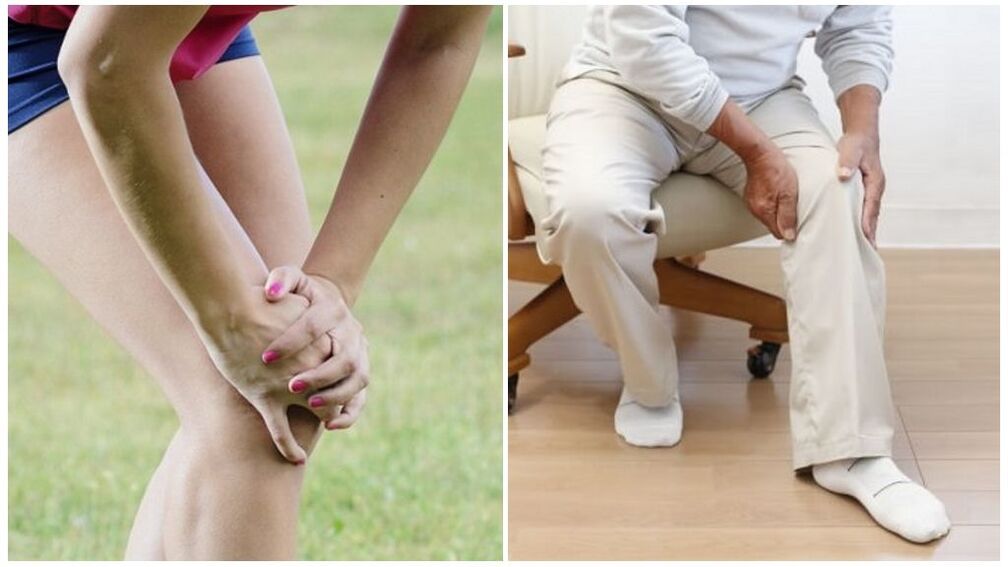
Articular cartilage does not wear away immediately. In the early stages, manifestations of the disease are absent or insignificant, the patient does not consult a doctor and does not take any measures to stop the pathological process. However, if dystrophic changes are identified, the patient will have time to begin treatment and prevent irreversible changes. To do this, you must first determine what the main signs of knee osteoarthritis are.
How to recognize the disease
Symptoms of knee osteoarthritis become evident when the cartilage is thinner and begins to deteriorate. Grade 1 gonorrhea may not appear for many years. However, attentive patients later recalled that they still felt atypical symptoms, they simply did not take them seriously because they were intermittent and did not cause much discomfort.
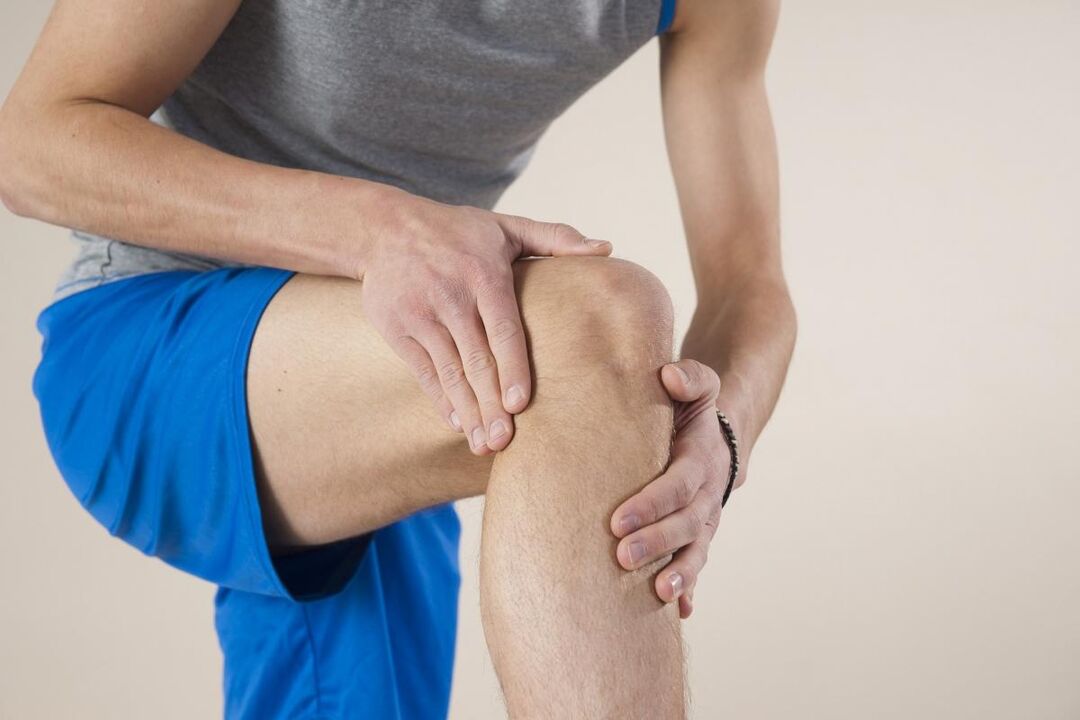
You can suspect destruction and arthritis of the right or left knee based on the following specific signs:
- morning stiffness;
- limit movement after a long period of time in one position;
- discomfort in the knees when climbing stairs - burning sensation, sensitivity;
- knee pain at night;
- pain after physical labor or sports;
- sudden periodic weakness of the lower extremities. If right gonorrhea or left gonorrhea develops then only the affected leg will give way.
However, the main symptom of knee joint destruction is still pain. They can vary in intensity and sometimes gradually decrease. But as the disease progresses, they appear more often, become more intense and make the patient uncomfortable even when resting or not physically active. Based on the severity of the symptoms, the doctor can diagnose the stage of the disease.
- Symptoms of stage 1 pathology:Pain is not yet a cause for concern, the patient may quickly notice fatigue when playing sports or physical activities, and slightly limit joint movement after prolonged rest. X-rays will show a slight narrowing of the space between the bones and joints, an uneven and slightly compressed cartilage surface.
- For gonorrhea 2 degreesSymptoms appear brighter and more frequent. Patients often understand that something is wrong with their knee. Joints hurt and "twist" when the weather changes and after exertion. Even the gentlest movements can cause pain in the knees. If a person gives their leg a rest, the pain will go away. But under load they will resume again. Also at this stage of the disease, the knee may have a characteristic crunching sound when bending and extending the leg, difficulty and pain when trying to bend the leg at the knee more than 90 degrees. X-rays will show changes in the shape of the joint cup and the presence of fluid in the joint cavity.
- Gonorrhea 3 degreescharacterized by severe pain that occurs regardless of whether the limb receives a load or is at rest. Joint pain is especially painful at night and when weather conditions change. The patient was no longer able to flex his leg at the knee, which was why his physical activity and performance decreased. X-rays clearly show degenerative changes in joint tissue. Deformation can also be seen with the naked eye. The patient's legs are bent at the knee like an "o" or "x", eventually leading to the inability to move independently, without support, and even more so to perform common household and occupational tasks. often. The person becomes disabled.
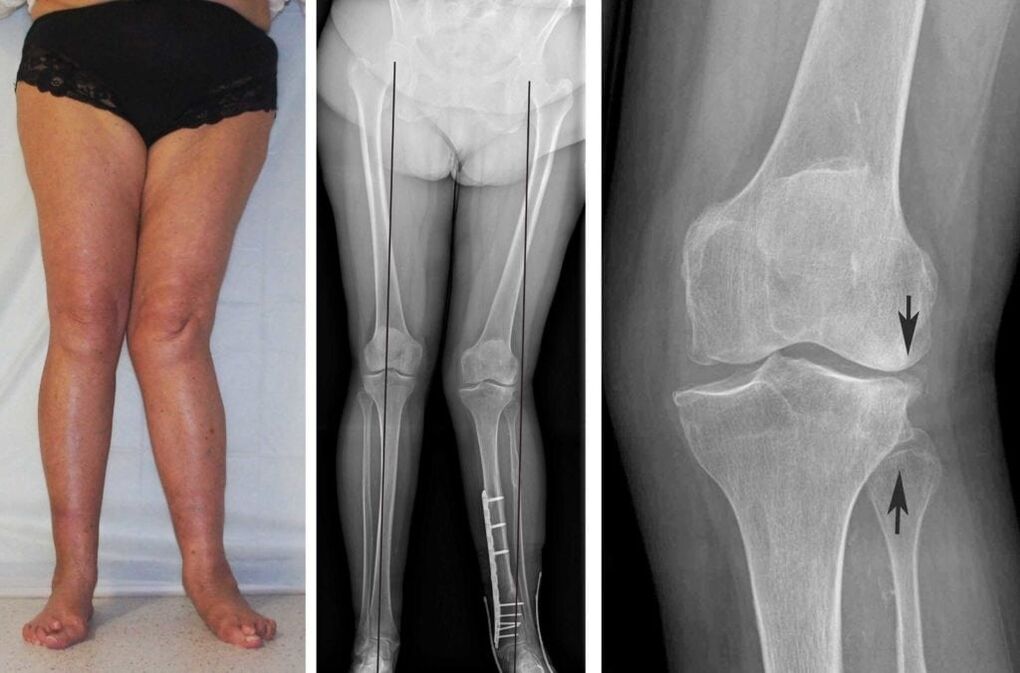
Usually, patients consult a doctor in the second stage of the disease, mainly to find an effective medication for knee pain. In the early stages, it is quite difficult to identify gonorrhea because the symptoms are mild and only minor changes are visible on X-rays. Pathological changes in the joints can only be detected with a thorough examination.
Diagnostic method
Diagnosis begins with a visual examination and asking the patient questions. What will indicate the possible development of gonorrhea:
- widening and changing the shape of the knee joint;
- a distinct crunching sound when the kneecap is displaced;
- pain when palpating the joint;
- limits joint mobility.
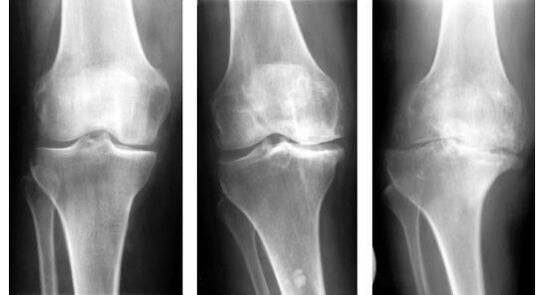
In the early stages, degenerative changes in cartilage tissue may not be visible; For this reason, CT and MRI are recommended in addition. With the help of modern diagnostic techniques, the doctor can accurately determine the severity of the joint, whether there is inflammation and fluid accumulation in the joint cavity, and also distinguish osteoarthritis of the joint. pillow with other diseases.
Classify
In modern orthopedics, there are two main types of osteoarthritis in the knee joint:
- primary gonorrhea;
- secondary gonorrhea.
The primary form of the disease develops spontaneously due to age-related changes or metabolic disorders. Secondary is the result of another disease, trauma or unsuccessful surgical intervention. Post-traumatic osteoarthritis of the knee joint can develop several months after a bruise, dislocation, or fracture. According to the nature of the course, joint diseases are classified as acute or chronic. It is easier to treat the acute form of the disease.
Official medicine for gonorrhea
Complex treatment of osteoarthritis of the knee joint begins only after confirmation of the final diagnosis. If the patient's condition is not critical, doctors will first try to stop the progression of the pathology with the help of drugs. Physical therapy, massage, and manual therapy are used as complementary methods.
The main goals of complex therapy:
- reduces pain and discomfort;
- restore joint mobility;
- prevent the destruction of the cartilage layer and, if possible, restore it.
The important point is physical therapy and following a special diet. There are exercises and products that work to restore damaged joint tissue and help restore at least partial mobility. If you consult a doctor in time, these measures are enough for the knee joint to begin to function normally again.
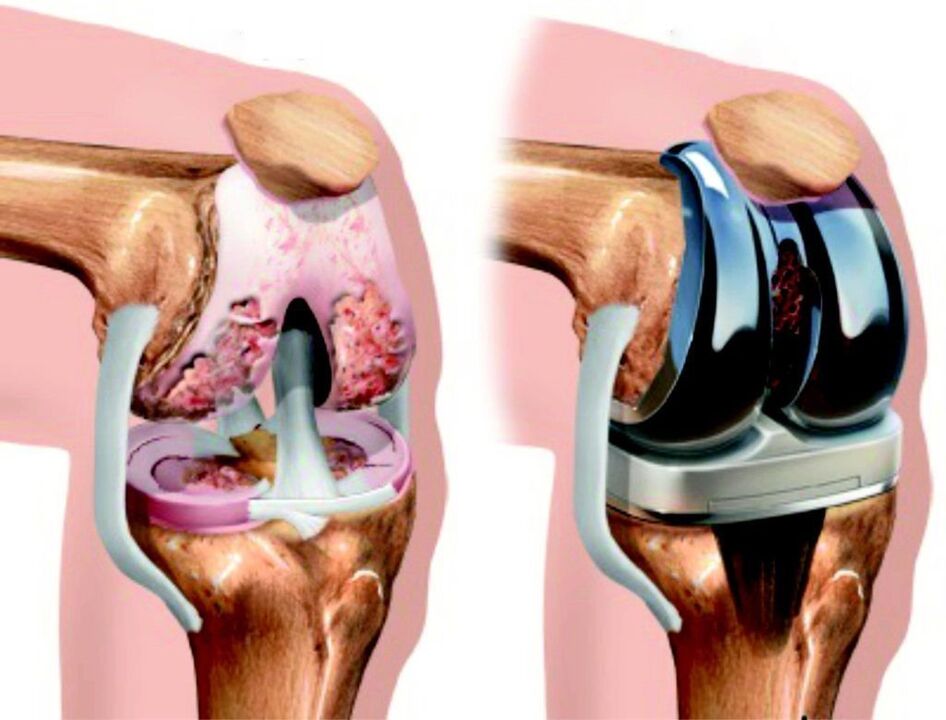
But if the disease has reached stage 3 and the joints are severely damaged, even the most expensive drugs will not help recovery. Surgery will be required to preserve at least partial function of the limb. It involves removing the remainder of the affected joint structures and inserting an implant, a procedure called arthroscopy.
Medicines to treat gonorrhea
To eliminate the unpleasant symptoms of the disease, restore and strengthen the joints, a complex of drugs consisting of different groups and effects is used.
- Nonsteroidal anti-inflammatory drugs– joint treatment begins with them, they quickly relieve pain, swelling, fever and partially stop the inflammatory process. But they cannot be used long-term because the active ingredients in the preparation have an extremely negative effect on the function of the gastrointestinal tract and blood composition. Usually, treatment with NSAIDs lasts no more than 5-7 days. The medicine may be in tablet form for internal use or in ointment and gel form for external use.
- Chondroprotectors– these are drugs that help improve the nutrition of cartilage tissue and restore their firmness and elasticity. Chondroprotectors also partially reduce pain and swelling. But such drugs do not work immediately. The first effects will be visible a few weeks after starting the treatment course. Chondroprotectors should be used for at least six months.
- Hormonal drugs.They are also called corticosteroids. Hormone-containing medications are used if pain is very severe and inflammation continues even after a course of NSAIDs. They are administered as intramuscular injections or directly into the joint cavity. Such drugs provide immediate pain relief, reduce swelling and inflammation. But they have some contraindications and even more side effects than nonsteroidal anti-inflammatory drugs, which is why they are prescribed in severe cases. Hormonal drugs can be purchased in pharmacies only with a doctor's prescription. As soon as the patient's condition improves, corticosteroids are discontinued.
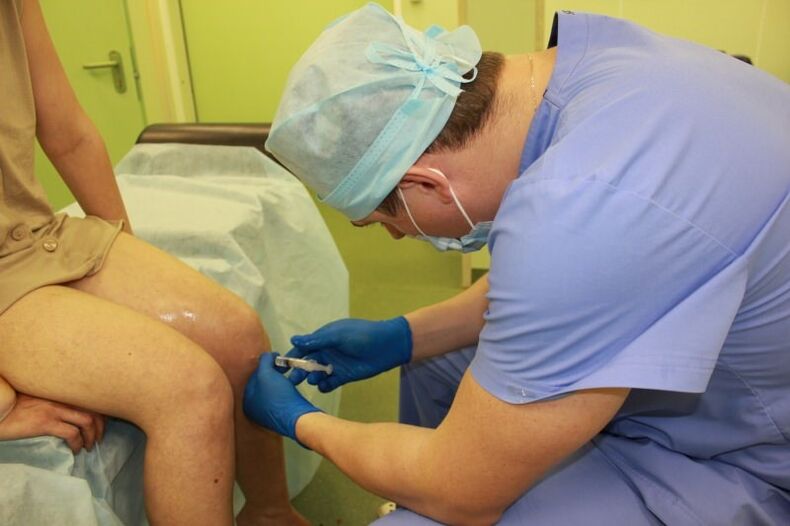
Treatment is supplemented by injections of hyaluronic acid into the joint. This substance stimulates the production of synovial fluid, saturates cells with moisture, restores elasticity, firmness and prevents wear. The cost of the procedure is quite high, but the effect is worth it.
On a note:Of all the drugs listed above, only chondroprotective drugs have a pathogenic effect. They stimulate regeneration of destroyed cartilage tissue and prevent damage to remaining cartilage cells. But these drugs are expensive, while to obtain a noticeable and lasting effect, they must be used regularly for several consecutive months, and sometimes even years. The cost of full treatment for many patients, especially retirees, is often very high.
Unique treatment method
Patients who have experienced firsthand what knee arthritis is and the unpleasant symptoms it presents always have a number of remedies available in the absence of pharmacies and medications. People suffering from gonorrhea and knee pain prepare in advance tinctures, balms and ointments made from medicinal plants - almost all recipes require time and fresh ingredients, available only in the spring-summer season.
Treatment with dandelion
There are several ways to strengthen the joints and restore their mobility, while getting rid of severe pain with the help of this medicinal plant. The simplest way is to eat five dandelion heads every day during the flowering period. This should be done on an empty stomach, after washing the flowers with boiled water. A tincture for rubbing joints is also prepared from dandelion.
Recipes are as follows:
- Collect exactly 50 blooming dandelion heads.
- Put in a dark glass bottle with a tight-fitting stopper.
- Pour in 300 ml of good vodka or triple cologne.
- Soak in a place protected from sunlight for a month, shaking the container occasionally.
- No need to squeeze, transfer to first aid box, use before going to bed to rub on sore knees, then warmly wrap the joint and cover the bed with a blanket.
There is another interesting recipe against osteoarthritis with dandelion. First you need to collect the leaves of the plant and dry them. Then pour boiling water and leave for half an hour to steam. The resulting mixture must be chewed slowly and thoroughly for exactly 3 thousand steps.
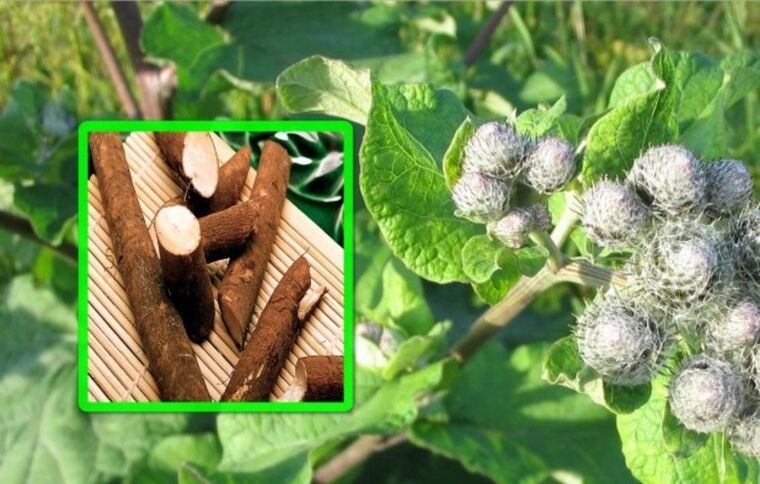
Recipes with burdock
The simplest formula:
- Pick two or three young leaves of the plant and wash them with cold water;
- Gently grind the leaves to release the juice;
- Apply to the affected joint and secure with a bandage.
Keep this "compress" overnight, take it out the next morning and throw away the leaves. Repeat the procedure daily for three weeks.
To enhance the effect, traditional healers recommend lubricating the knees with cinquefoil oil before applying burdock. It is very easy to prepare. Two tablespoons of chopped cinquefoil leaves are poured into 250 ml of pure, fragrance-free vegetable oil. The oil must be preheated, but not boiled. Leave the mixture for two weeks, after which the oil can be used to treat joints.
Turpentine, eggs and other joint remedies
Using egg yolks, you can make an effective massage mixture to treat joint pain. It is prepared like this:
- Lightly beat one yolk in a bowl.
- Add a small spoonful of turpentine and stir well.
- Then pour in a large spoonful of vinegar and beat again.
The mixture is stored in the refrigerator and used before going to bed. After rubbing, the knee is wrapped in a warm cloth overnight. In the morning, you need to remove the bandage and wash off the remaining product with warm water, then apply any anti-arthritis ointment.
Remember that all homemade preparations are effective only immediately after preparation, they cannot be stored for a long time (except for tinctures, they can be stored in a cool, dark place in the dark). maximum six months). Don't expect immediate results. Folk remedies work on a cumulative system, long-term relief will come only after three to four weeks of regular use of home remedies for knee arthritis. In the later stages, they will no longer be effective and will only help temporarily reduce pain and swelling.
Summary:Knee osteoarthritis or gonorrhea is one of the most common lesions of the musculoskeletal system in older people. In young people, it occurs after injury or overexertion. The disease can only be completely cured at stages 1-2 with a competent and comprehensive approach. In the third stage, endoscopy is often required to restore at least part of the limb's function and prevent complications.



























